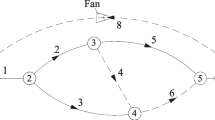Abstract
A calibrated and well-tuned ventilation network model plays a critical role in mine ventilation planning, optimization, and ventilation control. Moreover, it is critical to the mine fire simulation program as well since the fire simulation is built upon the mine ventilation model. The contaminants generated from a fire are transported by airflows throughout the mine ventilation system. The accuracy of the fire simulation results not only depends on the fire source model itself but also on the ventilation network model. With the increasing use of atmospheric monitoring systems in underground mines, airflow is continuously monitored using airflow sensors in the key areas of mines to ensure a steady and reliable ventilation. Experimental studies have been conducted at an experimental mine, the Safety Research Coal Mine (SRCM), to gain a better understanding on how to use the continuously monitored airflow data to improve the calibration of the mine ventilation network model. This paper introduces an improved method to calibrate a ventilation network using continuous airflow monitoring and addresses the practical problems encountered while calibrating and tuning the ventilation network of the SRCM using continuously monitored airflow data. In this study, the fluctuation of the air velocity sensor readings is analyzed, and the sensor location correction factors are applied to obtain a more accurate average air velocity for the ventilation network calibration.









Similar content being viewed by others
References
Bahrami, D., Yuan, L., Zhou, L., and Rowland, J.H. (2019). New mine fire location model utilizing real-time gas monitoring Data. 17th North American Mine Ventilation Symposium, Montreal, Canada, pp 30–37.
Baris, K., Adydin, Y., (2020). Atmospheric monitoring systems in underground coal mines revisited: a study on sensor accuracy and location. Int. J. Oil, Gas and Coal Technology, Vol. 23, No. 3, 2020.
Danko, G., Bahrami, D., Chao, L. (2015). Mine ventilation model calibration with numerical optimization, Proceedings of the 15th North American Mine Ventilation Symposium, Blacksburg, VA, June 20–25 pp.157–162.
Howden, VentSim 3D mine ventilation simulation software [Computer Software], retrieved from https://ventsim.com in 2020.
Iannacchione A., Joseb A., Hornc, T., Iannacchione, G., Iannacchione, S. (2015). Modeling the ventilation network at NIOSH’s Safety Research Coal Mine, Proceedings of the 15th North American Mine Ventilation Symposium, June 20–24, 2015, Blacksburg, VA.
McPherson, M.J. (2009). Subsurface ventilation engineering (2nd Edition), published by Mine Ventilation Services, Inc.
NIOSH (2020). MFIRE [Computer Software], retrieved from https://www.cdc.gov/niosh/mining/works/coversheet1816.html.
Rowland, J.A. (2012). Barometric resistance surveys: a new perspective. Proceedings of the 14th North American Mine Ventilation Symposium, June 17–20, Salt Lake City, UT.
Strata Mechanics Research Institute at Polish Academy of Science (SMRI), VentGraph [Computer Software], retrieved from https://imgpan.pl/en/oferta/ventgraph in 2020.
Xu, G., Huang, J., Nie, B., Chalmers, D., Yang, Z. (2018). Calibration of mine ventilation network models using the non-linear optimization algorithm. Energies, 2018, 11, 13; doi:https://doi.org/10.3390/en11010031.
Zhou L, Yuan L, Thomas RA, Iannacchione A (2017) Determination of velocity correction factors for real-time air velocity monitoring in underground mines. International Journal of Coal Science and Technology 2017(4):322–332
Zhou L., Yuan L., Bahrami D., Thomas R.A., Rowland JH (2018) Numerical and experimental investigation of carbon monoxide spread in underground mine fires. J Fire Sci 36(5):406–418
Zhou, L., Yuan, L., Bahrami, D., Thomas, R.A., Cole, G. (2019). Study on integration of real-time atmospheric monitoring system monitoring data and MFIRE simulation. Proceedings of the 16th North American Mine Ventilation Symposium, Montreal, Canada, April 28-May 1, pp. 794–803.
Zhou, L., Yuan, L., Thomas, R.A., Bahrami, D., Rowland, J.H. (2020). Determination of a mine fire intensity using atmospheric monitoring system in a ventilation network. Proceedings of 2020 SME Annual Conference & Expo, Phoenix, AZ, February 23–26, Preprint 20–005.
Zhou, L., Thomas, R.A., Yuan, L., Bahrami, D. (2021). Improving calibration of a mine ventilation network using continuous airflow monitoring, Proceedings of the 18th North American Mine Ventilation Symposium, Virtual, June12–17, pp 518–528.
Acknowledgements
The authors wish to thank John Soles and Jarod Myers of the Pittsburgh Mining Research Division for conducting the full-scale AMS test. Data from this manuscript had been presented at the virtual 18th North American Mine Ventilation Symposium, June 12-17, 2021.
Author information
Authors and Affiliations
Corresponding author
Ethics declarations
Conflict of Interest
The authors declare no competing interests.
Disclaimer
The findings and conclusions in this report are those of the authors and do not necessarily represent the official position of the National Institute for Occupational Safety and Health, Centers for Disease Control and Prevention. Mention of any company or product does not constitute endorsement by NIOSH.
Additional information
Publisher's Note
Springer Nature remains neutral with regard to jurisdictional claims in published maps and institutional affiliations.
Rights and permissions
About this article
Cite this article
Zhou, L., Thomas, R.A., Yuan, L. et al. Experimental Study of Improving a Mine Ventilation Network Model Using Continuously Monitored Airflow. Mining, Metallurgy & Exploration 39, 887–895 (2022). https://doi.org/10.1007/s42461-022-00574-4
Received:
Accepted:
Published:
Issue Date:
DOI: https://doi.org/10.1007/s42461-022-00574-4




